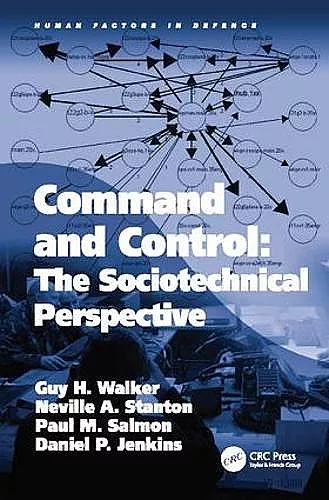Command and Control: The Sociotechnical Perspective
Neville A Stanton author Guy H Walker author Daniel P Jenkins author
Format:Paperback
Publisher:Taylor & Francis Ltd
Published:31st Mar '17
Currently unavailable, and unfortunately no date known when it will be back
This paperback is available in another edition too:
- Hardback£160.00(9780754672654)

Military command and control is not merely evolving, it is co-evolving. Technology is creating new opportunities for different types of command and control, and new types of command and control are creating new aspirations for technology. The question is how to manage this process, how to achieve a jointly optimised blend of socio and technical and create the kind of agility and self-synchronisation that modern forms of command and control promise. The answer put forward in this book is to re-visit sociotechnical systems theory. In doing so, the problems of 21st century command and control can be approached from an alternative, multi-disciplinary and above all human-centred perspective. Human factors (HF) is also co-evolving. The traditional conception of the field is to serve as a conduit for knowledge between engineering and psychology yet 21st century command and control presents an altogether different challenge. Viewing military command and control through the lens of sociotechnical theory forces us to confront difficult questions about the non-linear nature of people and technology: technology is changing, from platform centric to network centric; the interaction with that technology is changing, from prescribed to exploratory; and complexity is increasing, from behaviour that is linear to that which is emergent. The various chapters look at this transition and draw out ways in which sociotechnical systems theory can help to understand it. The sociotechnical perspective reveals itself as part of a conceptual toolkit through which military command and control can be transitioned, from notions of bureaucratic, hierarchical ways of operating to the devolved, agile, self-synchronising behaviour promised by modern forms of command and control like Network Enabled Capability (NEC). Sociotechnical system theory brings with it a sixty year legacy of practical application and this real-world grounding in business process re-engineering underlies the entire book. An attempt has been made to bring a set of sometimes abstract (but no less useful) principles down to the level of easy examples, design principles, evaluation criteria and actionable models. All of these are based on an extensive review of the current state of the art, new sociotechnical/NEC studies conducted by the authors, and insights derived from field studies of real-life command and control. Time and again, what emerges is a realisation that the most agile, self-synchronising component of all in command and control settings is the human.
'Walker, Stanton, Salmon and Jenkins have written a highly relevant book that describes what information technology can offer to command and control, acknowledging the importance of keeping the decision maker in charge. The sociotechnical perspective is broadened to reflect the challenges of complex environments, and the requirements for human factors integration. In short, the book presents a comprehensive framework.' Gary Klein, Applied Research Associates, USA 'This book aims to apply socio-technical theory to the design and practice of Network Enabled Capability. It succeeds and in so doing contributes substantially to our understanding of both domains. Especially interesting are the authors' propositions on the design and use of military equipment, and the presentation of some new guiding sociotechnical principles for design. The authors argue persuasively for the need to put humans at the centre of complex networked systems - Amen to that!' Chris W. Clegg, Leeds University Business School, UK 'In writing this book, the authors set themselves the ambitious goal of using HFI research to identify linkages between the various disciplines involved in NCW, then using those linkages to build conceptual bridges that ’reach out across various interdisciplinary boundaries’. This interdisciplinary approach, focused on understanding how the human operates in the NCW environment, offers a unique and valuable insight into modern command and control arrangements. The book’s extensive and thorough review of literature relating to organisational design will see many readers drawn out of their conceptual comfort-zone to alternative views that will nonetheless enhance their understanding of command and control in the informationage. Although some readers may at times find the data analysis impenetrable, the unique insights that this analysis provides makes the additional effort worthwhile. This book is a ’must read’ for all involved or interested in the develop
ISBN: 9781138076860
Dimensions: unknown
Weight: 453g
216 pages